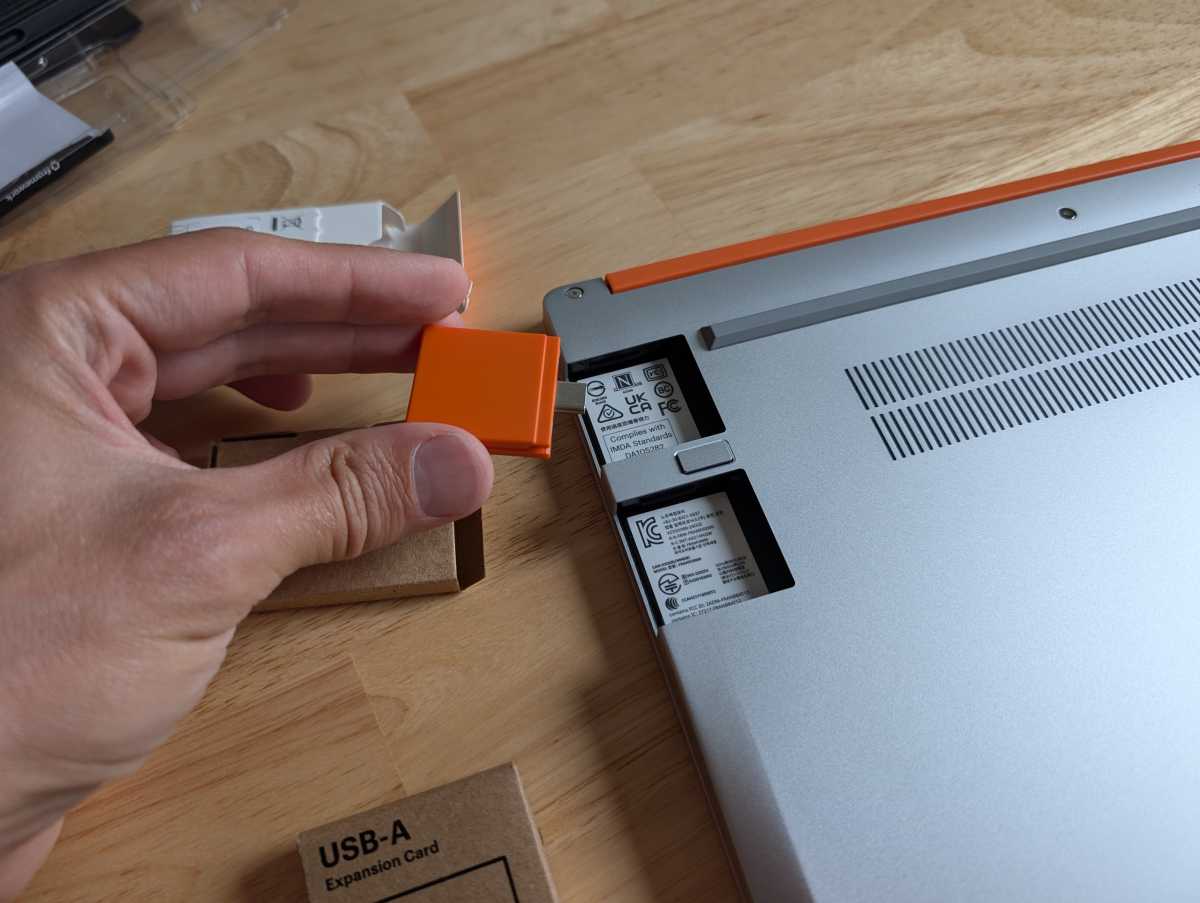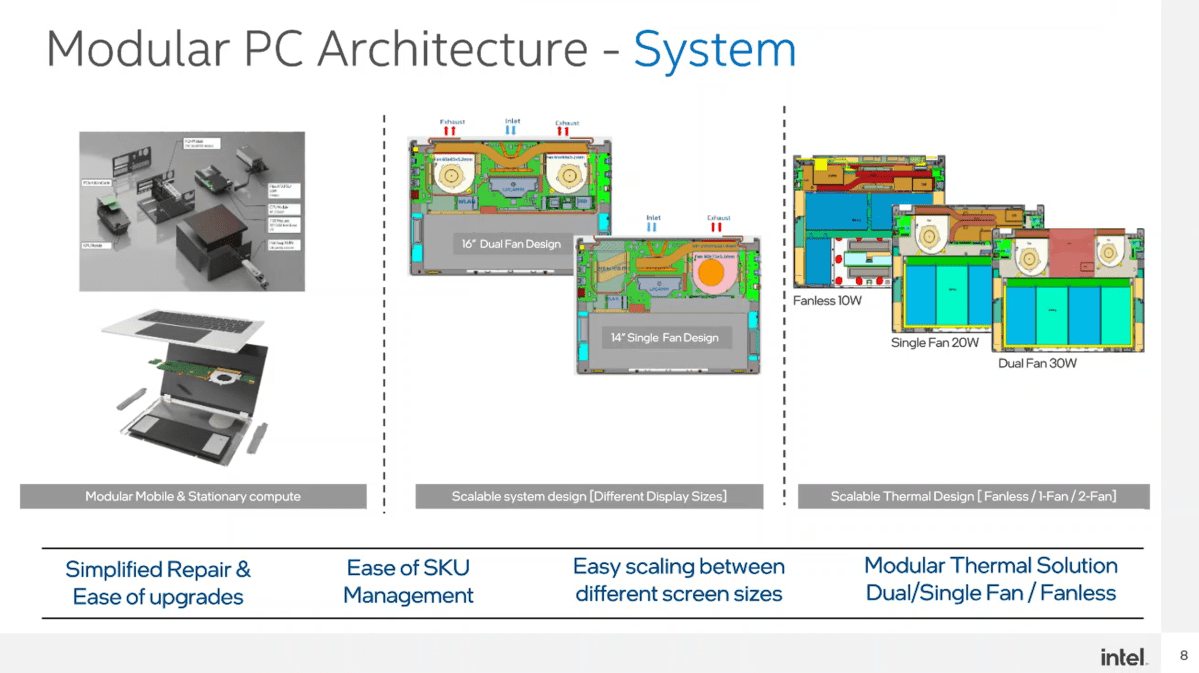A senior Intel executive said Tuesday that Intel has begun building more modularity into its laptop designs, allowing PC builders additional flexibility and consumers the ability to potentially replace or upgrade certain parts of the laptop.
Intel executive Gokul Subramaniam, vice president of Intel’s Client Computing Group and president of Intel India, said that the last two or three generations of Intel’s designs have featured increased modularity inside the laptop, to assist companies such as Asus or Acer with designing multiple versions of a laptop without extensive re-engineering.
The concept in question is what’s known as modular design. Desktop PCs were basically founded upon this principle, allowing PC makers and consumers alike to slide out hard drives and optical drives, or unscrew and replace SSDs in M.2 slots in today’s PCs. Laptops, though, have traditionally been considered sealed boxes, and just being able to access the internals is a prized feature that not every laptop offers.
The message? Modularity’s time is now. PC makers can easily manufacture multiple versions of a product, and swap out a failing part quickly and relatively cheaply. Consumers, hopefully, will have some say in which peripherals and capabilities will appear on their PCs as well.

IDG / Chris Hoffman
One company, Framework, has viewed this as a business opportunity. Framework Laptops, and now its Framework Desktop, feature modular components that can be easily replaced, such as swapping out a USB-C port for a legacy USB-A connector. Subramaniam used a similar example in discussing modularity in a brief talk with reporters.
Intel is working to make PCs more modular at the system, board, and component level, Subramaniam said. (Two of the three will benefit laptop makers directly.) At the system level, Intel is co-designing entire boards with its partners, so as to enable a single design for a 16-inch, dual-fan laptop, as well as a second design for a 14-inch, single-fan design. Shipping the larger laptop or the smaller laptop would enable simply inserting the board into the laptop chassis.

Intel
Intel is also trying to split up the laptop motherboards, sub-dviding them into two or three or even multiple PCBs, all connected by cables or connectors. Again, the idea is that customers like ordering from a menu of parts, with specific capabilities; in response, PC makers could simply connect individual cards or small daughterboards with wireless modules. Subramaniam identified M.2 modules as one key piece of the modular approach, since it was an easy way for a PC maker or consumer to swap out cards and capabilities alike.
Finally, there is modularity at the user level, such as a user-replaceable SSD. Some vendors allow this, and access to the insides of a laptop has been one of the sticking points of the right-to-repair movement. But one of the neatest features of Framework has just been the ability to swap out a cheap peripheral port.
“One of the key things is the requirements of the end user is constantly changing,” Subramaniam said. “The interests are varying. You have a variety of user needs.”
Some people may be happy with the laptop’s default camera, Subramaniam said. But others would want to swap out the camera for something better, without needing to buy a superior webcam.
If there was any drawback to Intel’s new approach, it’s that it seems focused on the PC vendor, not the consumer. Intel’s Subramaniam did not propose a forthcoming reference design with swappable I/O modules, for example. And there’s nothing like the Open Compute Project — an open-source design for making a reference server that’s a decade old.
Basically, Intel’s stance right now is that modular computing is a good thing, and that it’s feeling its way through with customers in order to simplify the process of developing more standardized, upgradable laptops. But Subramaniam did not indicate that Intel or the PC industry is working toward a world where you’ll be able to open up a laptop and swap out a motherboard…you know, like Framework does. There’s no sign that a Microsoft Surface or an Acer Swift will do the same.

Intel
Modular PC designs, of course, offer all sorts of intriguing possibilities: easily swapping out or upgrading I/O, or even replacing an entire motherboard or CPU. Would a modular laptop need to be thicker to accomodate the flexibility? Would PC makers prefer the benefits of modularity while accepting the reality that they’re simply assembling PCs, rather than engineering them? All good questions, and ones we’ll have to leave for the future.
So while Intel says it loves modularity, we’ll have to see if it — and the rest of the PC industry — follows through.
https://www.pcworld.com/article/2687547/intel-wants-laptops-to-become-as-modular-as-desktop-pcs.html
Melden Sie sich an, um einen Kommentar hinzuzufügen
Andere Beiträge in dieser Gruppe

The Philips Hue app has grown in complexity over the past several yea

Though the Steam Deck has been imitated by major PC industry players

The best way to ensure your laptop never dies on you—whether you’re w

Just having a password set on your PC in Windows 11 isn’t a sure way

Okay, bargain hunters, settle in. This is probably the best deal I’ve

Is your mouse suddenly registering two clicks even though you swear y

Peter Parker is used to getting the short end of the stick. But even
